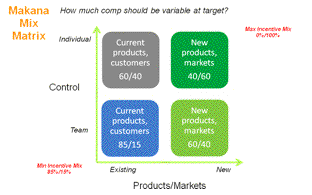Motivate the Right Behavior
The foundation of a successful sales strategy is an effective sales incentive plan -- one that is clear, motivating, and aligned with corporate strategy. This is vital to attracting and retaining the right salespeople and achieving sales goals. All too often I see plans that are unclear, leaving sales teams confused. Incentive compensation plans will undoubtedly drive sales team behavior -- so make sure your plans drive it in the way you intend.
However, I recognize that those who create sales incentive plans -- most often members of sales management -- have many responsibilities and don't always have the bandwidth to produce optimal plans. This four-step process is designed to help, provided you have established your business goals and your go-to-market strategy.
Step 1 -- Identify Eligible Job Roles
The first step is to identify the job roles you need to support your go-to-market strategy. Key factors to consider are:
- where your company stands in its customer-adoption life cycle; and
- the customer-facing roles needed for success.
For example, if your company is early in the life cycle, then market share might be the most important consideration. In that case, fostering "hunter"-type sales behavior, which will win new business, is a higher priority than encouraging "farming," which will cultivate existing customers.
The adoption life cycle is typically divided into four stages, which are outlined below with the typical job roles needed to succeed in each stage:
- Stage 1 -- Early Adopters: "Hunters"
- Stage 2 -- High Growth: "Specialists"
- Stage 3 -- Penetration: "Account managers"
- Stage 4 -- Saturation: "Farmers"
Next, review your customer-facing roles (Figure 1), and include any that have clear and measurable influence over customer behavior and that you are willing to offer at least 15 percent of the target total compensation as an incentive.
 |
| (Figure 1 -- Customer-Facing Roles) |
Step 2 -- Define Key Plan Elements
Next, define key elements of the compensation plan for each job role. These are the summary-level items important for staff role alignment and benchmarking pay, such as the target total compensation (TTC) and mix for each job role. TTC is the base salary plus incentive compensation when 100 percent of all goals are met. Mix is the ratio of salary to incentive. In establishing the TTC and mix for a job role, consider these factors:
- market pay;
- your budget;
- equity across plans;
- scope of the job;
- type of sale; and
- the required level of experience.
Next, clearly define performance measures and goals. Use a relevant mix of salary versus incentive for each job role, considering that the greater the customer influence, the higher the variable incentive component should be.
The matrix below provides some guidelines for evaluating the proper mix.
 |
| (Figure 2 -- Makana Mix Matrix) |
Your plans should have no more than three measures, and they should be tangible, such as bookings, orders, or new customers. Avoid subjective or qualitative measures: They are too difficult to accurately compare. In a team sales model, it's important to design the plans to encourage teamwork. Define specific crediting terms, measures, and payout timing. Keep the timing as close to the point of influence as possible, given any administration or cash-flow constraints.
Step 3 -- Model Your Costs
A key step that is often overlooked is modeling incentive costs at varying levels of attainment. Failure to do this can result in unintended financial consequences that can severely impact your bottom line. Accurate cost modeling allows you to check for full allocation of quotas and to see your incentive cost of sales in advance. In a complex selling model, it is especially important to look at the overall costs for all job roles -- including overlay or support roles. Additionally, modeling costs allows you to compare annual trends in your sales cycle, so you can compare against prior years.
Step 4 -- Produce Your Plan Documents
Last, but far from least, is production of the plan documents. This step is a big deal, as these documents drive strategy and must be very clear and motivating. The value of a great plan can get lost in a poor document. Terms and conditions should be well-defined and consistent. Aim for consistency of policies and definitions across roles. Circulate your plans among key stakeholders and especially legal, as, after all, your plans are contracts.
Focus on clarity and simplicity. It will help you motivate the right sales behavior within your sales teams.
About the author
Liz Cobb (lcobb@makanasolutions.com), founder and CEO of Makana Solutions (www.makanasolutions.com), has more than 20 years' experience in sales compensation design and automation.
Please note that the Viewpoints listed in CRM magazine and appearing on destinationCRM.com represent the perspective of the authors, and not necessarily those of the magazine or its editors. If you would like to submit a Viewpoint for consideration, please email viewpoints@destinationCRM.com.
Related Articles
Xactly Acquires Centive
23 Jan 2009
Analysts say consolidation in the sales performance management market was expected -- but this particular deal comes as a surprise.
Recession Deflates Noncash Incentives
22 Jan 2009
In a down economy, companies anticipate a negative impact on incentive programs for 2009, but a well-planned, well-implemented program may be just what they need to survive.
Makana Solutions Makes Plans
26 Nov 2008
A new sales compensation management tool joins the Makana Motivator family of products.